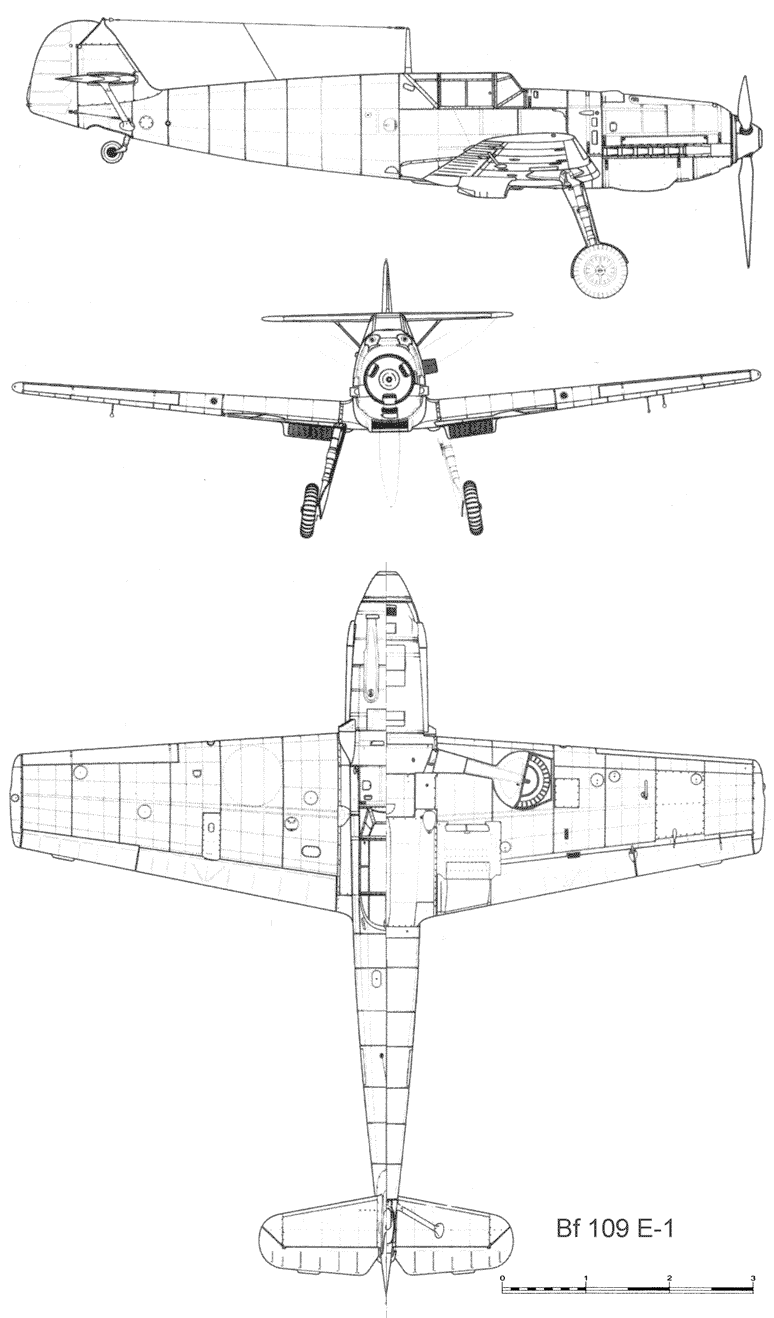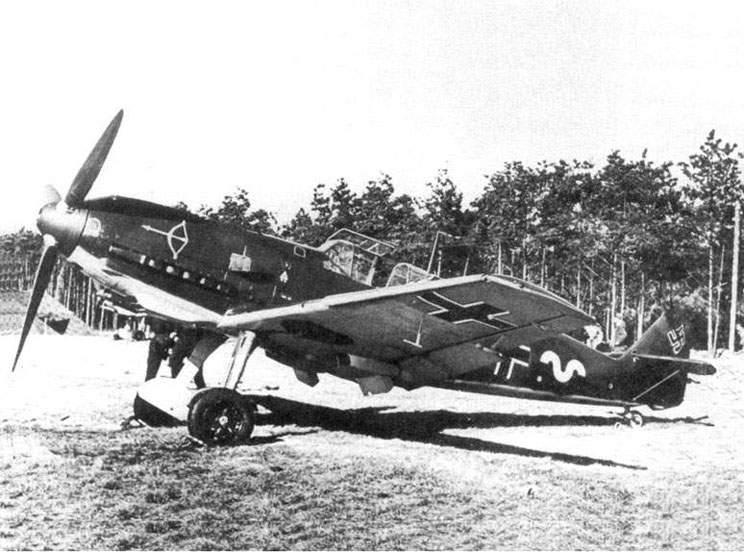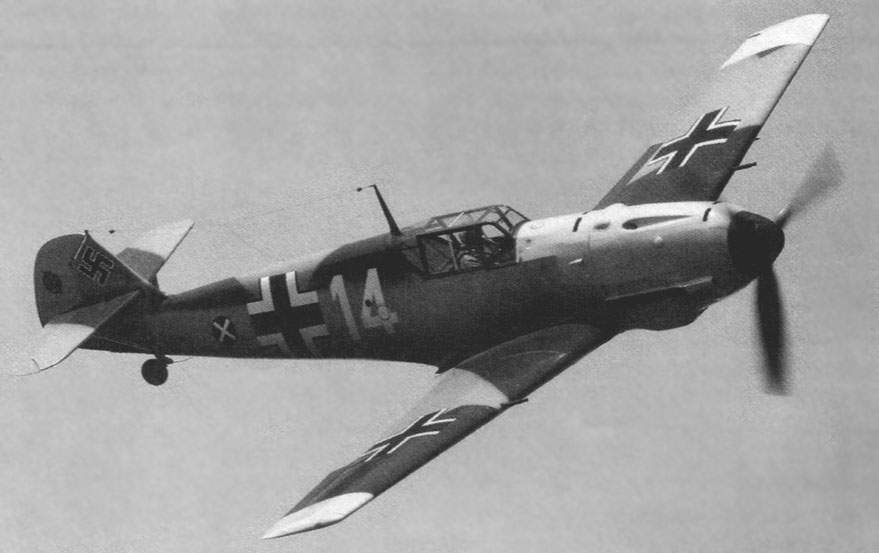|
Bf-109E
 |
- Fighter
- First flight: 1938
- Messerschmitt
|
 The main German fighter aircraft of the beginning of World War II. The Bf 109E ensured the success of the Luftwaffe over Poland, Scandinavia and northwestern Europe between September 1939 and June 1940. Its shortcomings were revealed only when these aircraft had to make long-range raids against British fighters in the Battle of England. Entered service at the end of 1938 and produced in the amount of more than 4000 vehicles, the Bf-109E ("Emil") was the same Bf-109D, but with a more powerful DB-601 engine and cannon armament. The main German fighter aircraft of the beginning of World War II. The Bf 109E ensured the success of the Luftwaffe over Poland, Scandinavia and northwestern Europe between September 1939 and June 1940. Its shortcomings were revealed only when these aircraft had to make long-range raids against British fighters in the Battle of England. Entered service at the end of 1938 and produced in the amount of more than 4000 vehicles, the Bf-109E ("Emil") was the same Bf-109D, but with a more powerful DB-601 engine and cannon armament.
The DB 601 had almost the same dimensions as the DB 600. The cylinders and pistons remained unchanged. The carburetor of the first was replaced by direct fuel injection on the second. The compression ratio was increased from 6.5 to 6.9, the boost was increased, and the supercharger received an automatic boost control system using a fluid coupling. Direct fuel injection reduced its consumption, allowed the use of gasoline with a lower octane number, and, unlike a carburetor, allowed the engine to work for a long time at negative overloads.
Of the early versions of this aircraft, the main ones were Bf 109E-1 with a 1075-horsepower DB 601A-1 engine, Bf 109E-3 with a more powerful engine, improved armor and a place for a 20-mm gun in the collapse of the engine cylinders, as well as Bf-109E-4 (without motor gun). The pilots considered the Emil one of the best Bf 109 models, at least equal to the early models of the Spitfire.
Armament: Me 109E - two 20-mm MG / FF wing cannons with 60 rounds of ammunition and 2 × 7.92-mm MG-17 machine guns with 500 rounds of ammunition per machine gun.
During the invasion of the USSR in June 1941, the Emil was already withdrawn from service, it remains a fact that Bf 109E also flew over the USSR for several months. It is known, for example, that JG 54 and the assault squadron SG 1 fought in this theater on Bf.109E.

Bf 109E-1 of 5./JG77 Black 4 of Anton Hacki Kristiansand Kjevik, Norway, June 1940
|
|
E-1 |
E-3 |
E-4 |
| Crew |
1 |
| Dimensions |
|---|
| Length, m |
8.76 |
| Wing span, m |
9.90 |
| Wing area, m² |
16.35 |
| Weight, kg: |
|---|
| Loaded weight |
1975 |
2060 |
|
| Powerplant |
|---|
| Engine |
DB601A-1 |
DB601Aa |
DB601N |
| Power, hp |
1075 |
1175 |
1200 |
| Performance |
|---|
| Maximum speed, km/h |
at sea level |
458 |
467 |
|
| at altitude |
555 |
560 |
|
| m |
5000 |
4440 |
|
| Rate of climb, m/s |
16.7 |
17.8 |
|
| Service ceiling, m |
10,972 |
11,000 |
|
| Service range, km |
560 |
560 |
|
| Armament |
|---|
| 7.92-mm MG-17 machine guns |
4 |
2 |
2 |
| 20-mm MG FF cannon |
- |
2-3 |
2 |
| External bombs load, kg |
4×50, 1×120 |
4×50, 1×120 |
4×50, 1×120 |
 |
Drawing Bf 109E-1
|
 |
Drawing Bf 109E-3
|
 |
The Bf 109E-1 from 1./JG20.
|
 |
Bf 109E in flight
|
|
Bf-109T
 |
- Сarrier-based fighter
- First flight: 1939
- Messerschmitt
|
At the beginning of 1939, V. Messerschmitt offered the sailors a technical design for a carrier-based Bf 109T fighter ("trager" - aircraft carrier). By design, it was close to the Bf 109E, but differed by an increased area and wingspan. In this regard, the slats and ailerons were lengthened, and the flaps also had a large area. Between the fifth and sixth fuselage frames, an attachment point to the catapult leash was provided. The landing hook was attached to the seventh frame. The structure in the indicated place was reinforced to withstand heavy loads. The consoles could be folded manually relative to the longitudinal hinges located on the outside of the gun installation nodes. The wing span in the folded state was reduced to 4.1 m, but folding the consoles was a rather laborious operation, since it was first necessary to disconnect the flaps. The Bf 109T project was accepted, but the production of a pre-production batch was entrusted to Fisiler. Right on the assembly line, the conversion of ten Bf 109E-1 airframes into pre-production Bf 109T-0 began; Fieseler subsequently received an order for another 60 Bf 109T-1s.
DB-601A engines were installed on Bf 109T-0 aircraft. To increase the glide angle during landing approach, spoilers were additionally installed on the upper surface of the wing. The increased loads during landing on the deck required the strengthening of the landing gear. After testing in Travemünde in the winter of 1939-1940. they were supposed to be transferred for military trials to 1I / JG186. However, after the outbreak of World War II, it was decided to suspend all work on the completion of the Graf Zeppelin aircraft carrier, since the only aircraft carrier could not have the required combat stability.
The assembly of Bf 109T-1 fighters at the Fiziler plant was stopped shortly after the suspension of work on the aircraft carrier. However, the successful combat use of British aircraft carriers in the Mediterranean at the end of 1940 again drew the attention of the German leadership to this type of ships. "Fieseler" was instructed to complete the production of 60 Bf 109T, but without special "aircraft carrier" equipment. The aircraft was manufactured as a fighter-bomber version adapted for operation from short runways.
Attachments to the catapult and landing hooks were removed from the aircraft, ventral holders for 300-liter tanks, four 50-kg or one 250-kg bombs were installed. This version, released in the spring of 1941, received the designation Bf 109T-2. The aircraft of this modification were equipped with DB-601N engines, which ran on 96-octane SZ gasoline. With a takeoff weight of 2800 kg, the Bf 109T-2 fighter had a takeoff distance of 500 m (with a climb of 15 m). Its minimum flight speed was only 120 km / h, and landing - 130 km / h.
Such aircraft were considered suitable for use from small temporary airfields, typical for the northern regions of Europe. In particular, the Bf 109T-2 fighters were transferred to the arsenal of the I / JG77 group, based in the Stavanger region. The re-equipment of the group from Bf 109E-3 to Bf 109T-2 began in June 1941, with one detachment transferred to Trondheim (later it was called the "separate detachment Trondheim"). On 24 January 1942, 1/JG.77, still armed with Bf 109T-2, changed its name to I/JG5. Shortly thereafter, the 3rd detachment was transferred to Hurdle Island near Bergen, where a wooden runway was equipped with a length slightly larger than the deck of an aircraft carrier.
In March 1942, an attempt by the battleship Tirpitz, escorted by light forces, to attack the northern convoys en route to Murmansk ended in failure due to detection by submarines, but the lack of fighter cover over the German squadron also played a certain role. As a result, Admiral Raeder again raised the question of the need to complete the construction of the aircraft carrier Graf Zeppelin. The order to resume work on the aircraft carrier was received on May 13, 1942, but by that time the Bf 109T-2 was already considered obsolete.
The good takeoff and landing characteristics of the Bf 109Т-2 made it possible to send the surviving aircraft to the so-called "Heligoland fighter detachment", formed on April 10, 1943 on the island of the same name. About 30 Bf 109T-2 fighters continued to be in the Reich air fleet until the summer of 1944, and then they were transferred to the 1V / JG5 fighter group.
|
| Crew |
1 |
| Dimensions |
|---|
| Wing area, m |
11.10 |
| Length, m |
8.8 |
| Height, m |
2.60 |
| Powerplant |
|---|
| 12-cylinder DB-601N Daimler-Benz, HP |
1,200 |
| Weights, kg |
|---|
| Empty weight |
2,000 |
| Loaded weight |
2,800 |
| Gross weight |
3,080 |
| Performance |
|---|
| Maximum over ground speed, km/h |
487 |
| Maximum speed at altitude, km/h |
572 |
| Maximum rate of climb, m/min |
1,020 |
| Service ceiling, m |
10,500 |
Flight range, km/h
with 300 l tank |
725
910 |
| Armament |
|---|
2 × 20 mm MG FF cannons with 60 rounds per barrel, and
2 × 7.9 mm MG 17 machine guns with 1000 rounds per barrel. |
 |
Drawing Bf 109T
|
|
Bf-109V-21
 |
- Fighter
- First flight: 1939
- Messerschmitt
|
The most mysterious modification of the Bf 109 is the Messerschmitt with a radial engine. In the summer of 1938, the company was given the task of designing the 109th for an air-cooled engine. The purpose of this experiment is unclear: according to one version, an export version of the aircraft was being prepared (Switzerland is called the client), according to the second, a full-fledged version of a combat aircraft was being prepared for the still unfinished BMW 801. Or BMW 139. Or maybe even a competitor or "insurer" FW 190.
On August 18, 1939, a Bf 109V-21 took off with an American Pratt & Whitney R-1830-SC-G Twin Wasp engine. The engine most likely came from a Ju 90 airliner ordered but not delivered to the South Africans. The V-21 (civil registration number D-IFKQ, serial number 1770) was created on the basis of a heavily redesigned Bf 109E-3. Surprisingly, according to the reports of the corporate tester, the aircraft performed well in the air, its behavior was similar to that of Emil. Later, he flew in the interests of the research organizations of the Third Reich Deutsche Forschungsanstalt für Segelflug (DFS) and Luftfahrtforschungsanstalt Hermann Göring e.V. (LFA) until at least September 1940.
 |
Drawing Bf 109 V-21
|
Read more...
Bibliography

- "Aviation of Luftwaffe" /Viktor Shunkov/
- "Encyclopedia of military engineering" /Aerospace Publising/
- "The air war" /№ 37, 62/
|







